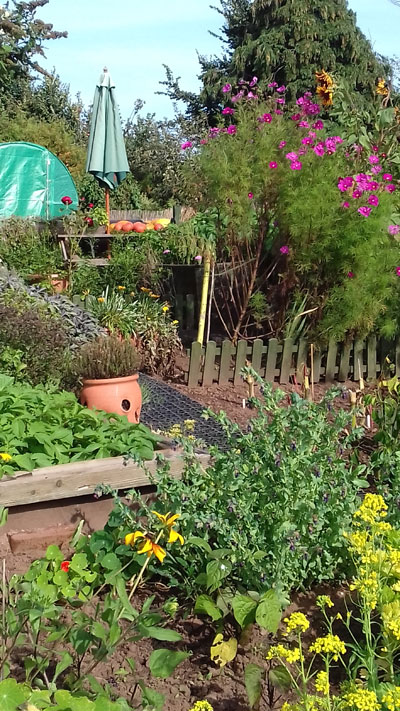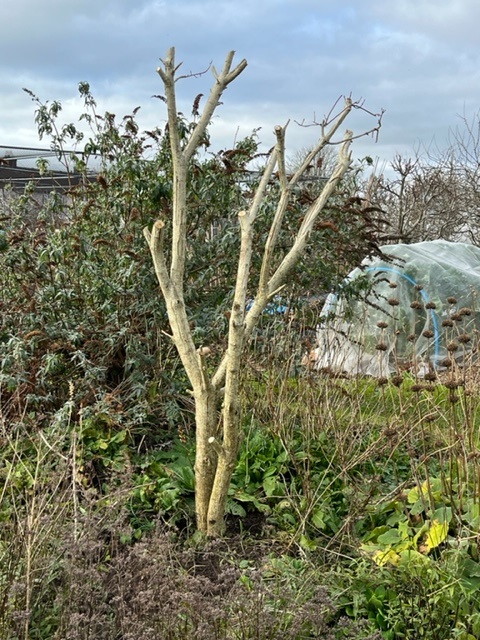 It's been quite a busy time on the wildlife plot because November to March is really when I can make some of the bigger changes that I want to do before seed sowing and planting take over on my veg plots. Noel has done sterling work and, just like Neptune holding back the sea, he has managed to hold back the advancing tide of Vinca major. It is now firmly under control, pooling in a circle around a tired buddleja, where it belongs!
It's been quite a busy time on the wildlife plot because November to March is really when I can make some of the bigger changes that I want to do before seed sowing and planting take over on my veg plots. Noel has done sterling work and, just like Neptune holding back the sea, he has managed to hold back the advancing tide of Vinca major. It is now firmly under control, pooling in a circle around a tired buddleja, where it belongs!
I have been building log piles.
This month's post is all about log piles for wildlife, why you might want them and different ways they can be constructed.
Why build a log pile?
They are perfect places for insects to hide. They are best in some shade, full sunlight dries out the wood and is not best for insects. Once you have insects and slugs and snails, other wildlife will follow such as birds, hedgehogs, slow worms, frogs and toads. They can be built in hidden corners and out of the way areas. Log piles in the sun are more for reptiles and insects that like to bask.
They are a perfect way to use all those bits of wood, twigs and branches from the plot so that you don't have to visit the dump or burn them. I have everything from raspberry cuttings to old root stumps on mine.
They mimic what happens naturally. In a forest, branches and twigs fall, as do old trees and they lie there on the soil, rotting down and completing the cycle not just of life but also of nutrients with the aid of things such as woodlice, beetles but also fungi and lichens.
Different types of log pile on the wildlife plot

This is the largest log pile. It is on the shady bank and as tall as me. It is roughly constructed with larger logs at the bottom and smaller ones on top but as more have been added it hasn't always been possible to do this.
You need quite a bit of space and a lot of wood for this type of pile.
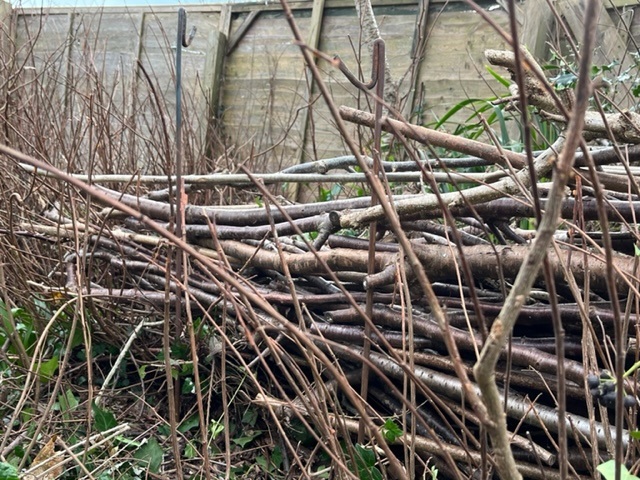
This is on the same bank but is a dead hedge. Metal rods have been hammered into the soil and then branches and logs placed length ways. The other side of the 'hedge' is not quite as neat but if you need a wood pile that looks a bit more pleasing, this might be one way to go.
Material can be added to this pile whenever it is available and as it rots down, more space is created. I have seen beautifully constructed versions of this which snake around a piece of land.
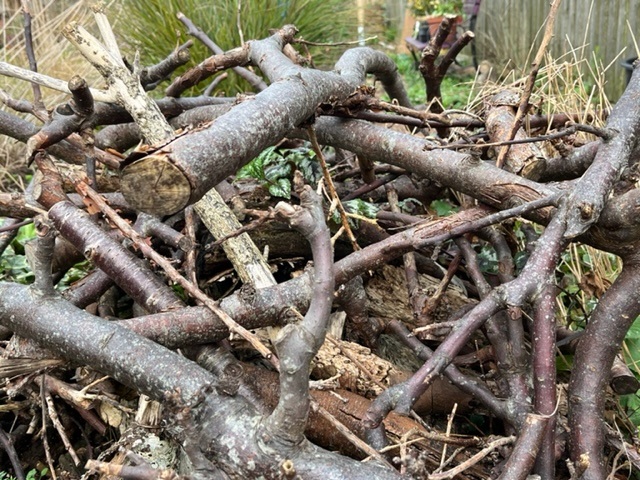
This is the oldest log pile on the plot on a shady corner near the shrubs. Again new logs have been placed on top and this time they tend to be oddly shaped pieces of wood. Dead nettle and harebells grow through and around this pile providing even more protection for the wildlife. There are definitely stag beetle grubs in this woodpile as I have seen them. It is a damp, shady spot and so ideal.
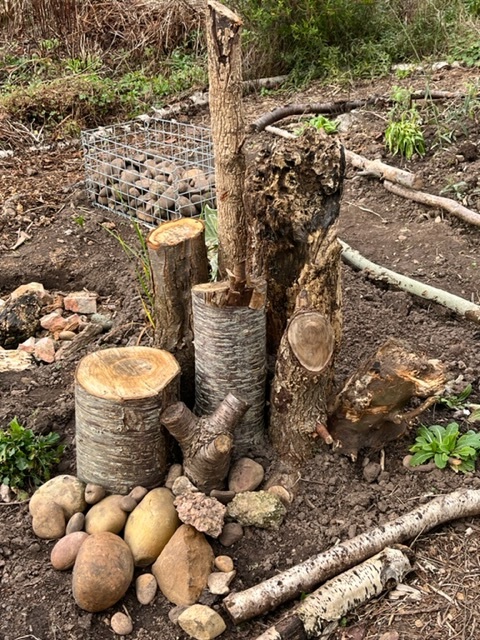 Log piles do not have to lie on the ground but can be created with the logs standing up. I dug a hole about 30cms deep, placed the logs in it and then back-filled the hole. This pile is south-facing so will be more suitable for insects that like to bask.
Log piles do not have to lie on the ground but can be created with the logs standing up. I dug a hole about 30cms deep, placed the logs in it and then back-filled the hole. This pile is south-facing so will be more suitable for insects that like to bask.
At the base of the pile are stones, providing more basking opportunities and behind, in its shade we planted a shrubby honeysuckle with a delicious scent. Some bare patches of soil will be left around it because many insects need more than one type of habitat to fulfill their life cycle.
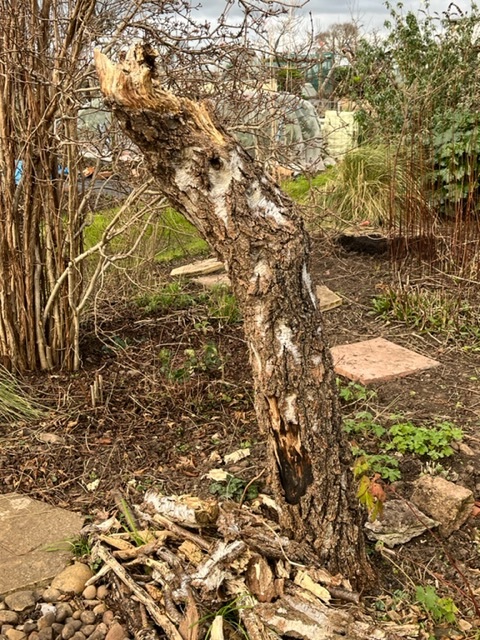 One of the easiest ways to create a wood pile is to leave a dead tree standing rather than cutting it down. As bits fall off the tree, a pile can be created on the ground around it. It is a fascinating process to watch, particularly as you can see different creatures creating different types of decomposition. There are holes and shredding and flaking.
One of the easiest ways to create a wood pile is to leave a dead tree standing rather than cutting it down. As bits fall off the tree, a pile can be created on the ground around it. It is a fascinating process to watch, particularly as you can see different creatures creating different types of decomposition. There are holes and shredding and flaking.
As the bark starts to peel away from the trunk, insects move in and start their work in a sheltered environment.
If you don't have any dead trees you can leave standing, the other thing that you can do is plant a dead tree. The Euonymus europaeus blew down in storm Arwin and the soil was so root ridden I couldn't plant it in the same spot it came out from so I planted it in the Thugs Bed and it can be seen in the picture at the very top of this post.
The plot also has tiny log piles made out of small branches dotted around the beds, mostly being twigs that have been left near where they fell.
I know there are some great log piles on other plots and will try and share some photographs of them in other posts. Let me know if you have one I could share with others.
